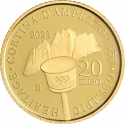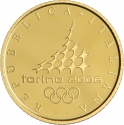You are about to finish your registration. Please check your mailbox (including spam folder). There should be a letter with a confirmation link. Check setting to make sure that your e-mail address is correct.
Send letter againDescription
To mark the event returning to the country for a fourth time in 2026 when Milan and Cortina d'Ampezzo hosts the Winter Olympics, the Ministry of Economy and Finance and the Istituto Poligrafico e Zecca dello Stato decided to release the coins celebrating the "History of the Olympics in Italy."
The Istituto Poligrafico e Zecca dello Stato has produced three gold coins with a face value of €20 dedicated respectively to the Winter Olympics at Cortina d'Ampezzo in 1956 and Turin 2006, as well as the Summer Games staged in Rome in 1960.
Artist: Valerio De Seta
Obverse

|
Depicts the official emblem of Rome 1960 Summer Olympics. The country name above. • REPUBBLICA • |
|---|---|
Reverse

|
Depicts the torch of Rome 1960 Summer Olympics standing out against the Colosseum, surrounded by the inscription “ROME 1960 – OLYMPIC HERITAGE”. The value and the issue year above, the mintmark “R”, identifying the Mint of Rome and the designer's name, below. • ROME 1960 • |
| Edge |
20 Euro
History of the Olympic Games in Italy
Rome 1960 Summer Olympics
Subscribe series
KM#
History of the Olympic Games in Italy
Rome 1960 Summer Olympics
Related coins
History of the Olympic Games in Italy





